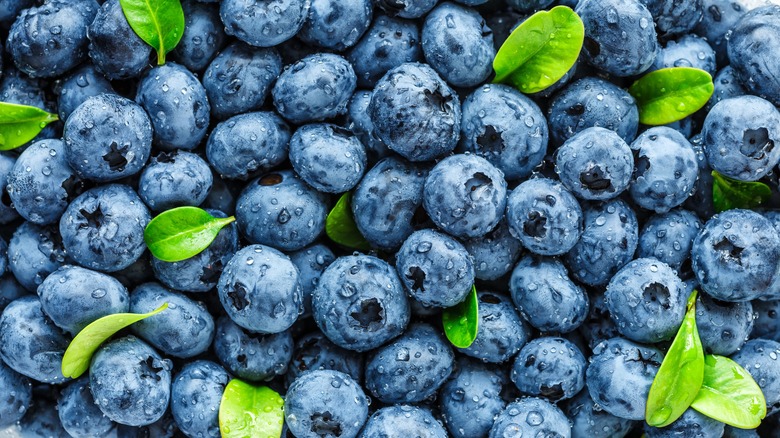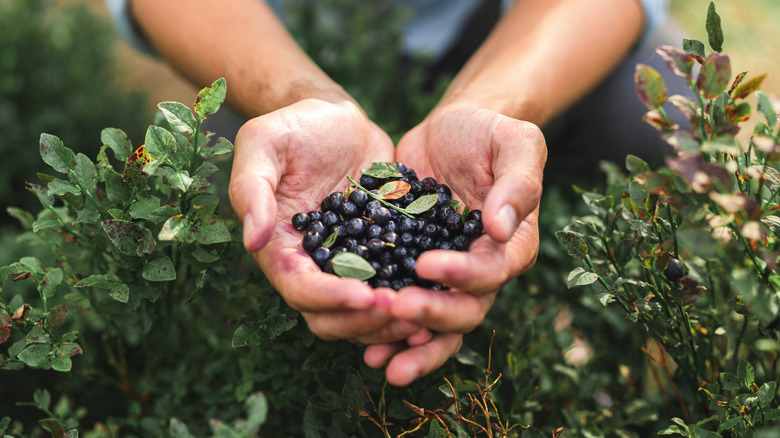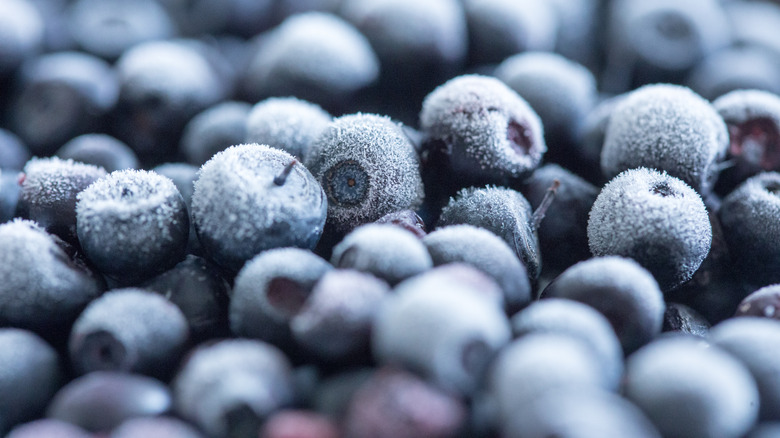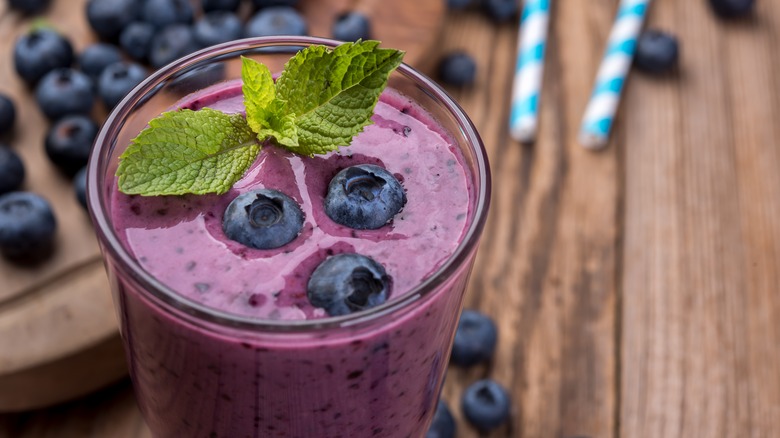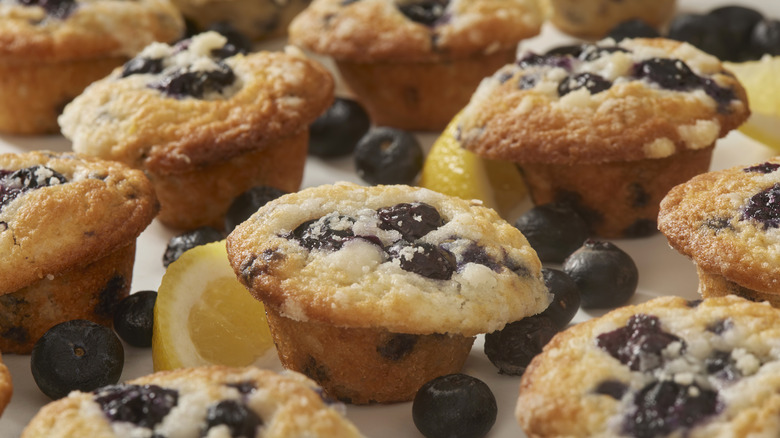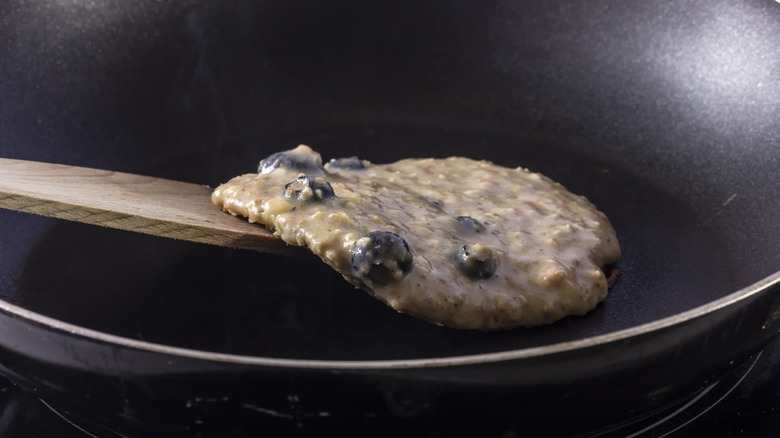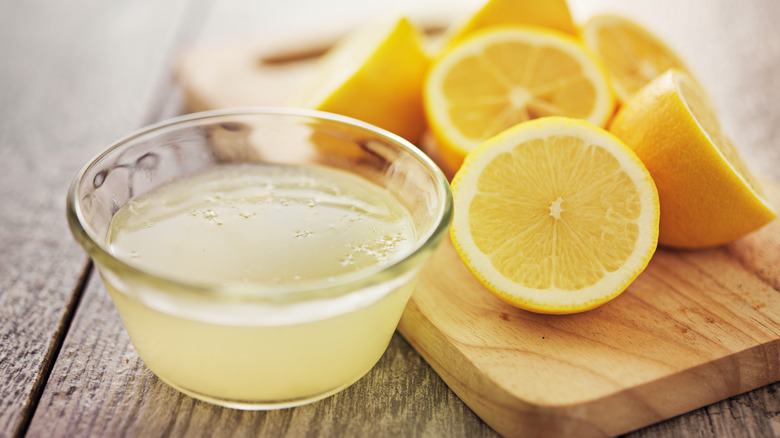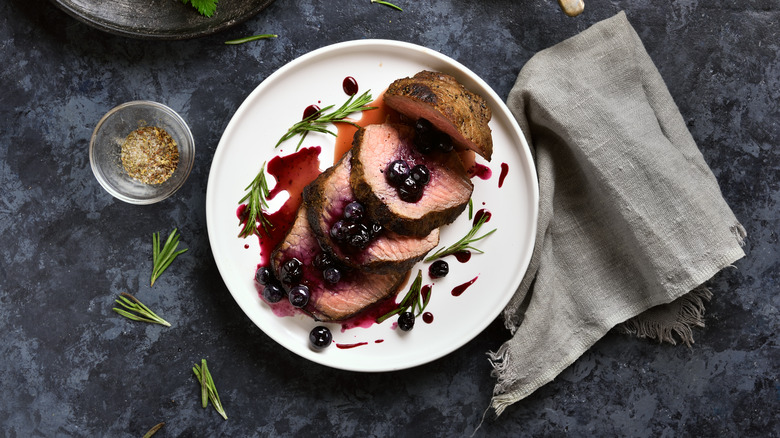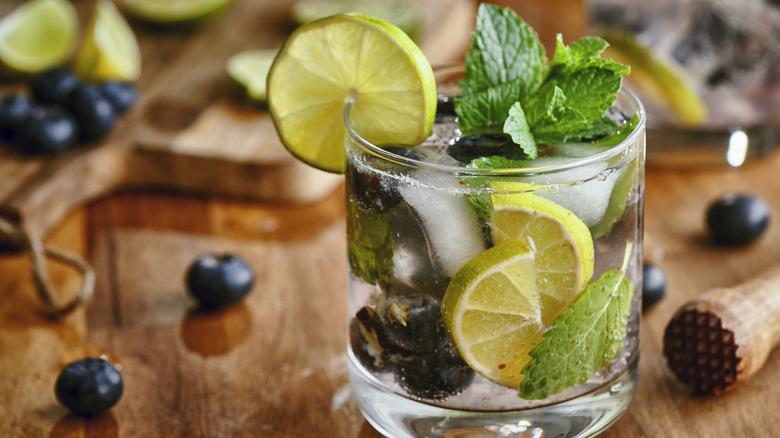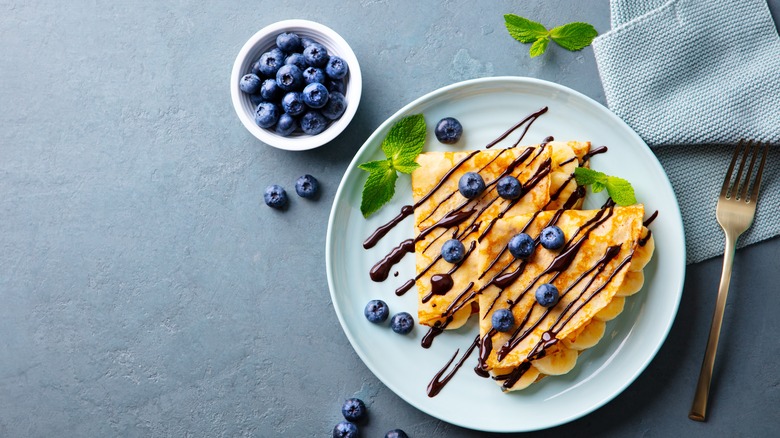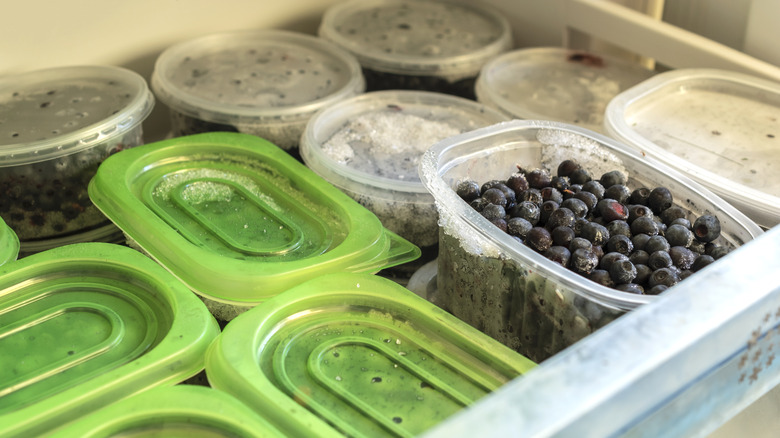10 Mistakes Everyone Makes With Blueberries
Have you ever tried to make batter for blueberry muffins and ended up with a greenish-gray goop in your bowl? Or have you ever brought home a box of painstakingly picked blueberries from the store or a farm, only to find out that they weren't truly ripe? Blueberries are delicious little fruits, but there are a lot of ways to go wrong with them.
Since blueberries are a great way to incorporate fiber, manganese, and vitamins C and K into your diet to promote heart, bone, and immune system health, it's worthwhile to learn how to use them correctly. In this article, we will help you correct some common mistakes made with blueberries, starting with how to pick them at peak ripeness. We will also let you in on the secret to keeping their color brilliantly blue even after baking, as well as how to keep that color from running into your batter and making things messy. We will also let you know how to choose between fresh and frozen blueberries and what benefits each kind offers so that next time you use blueberries, you'll be able to do so with confidence.
Mistake: Not knowing how to choose fresh blueberries
Perhaps the biggest and most distressing mistake made when using blueberries is choosing ones that are either under-ripe or over-ripe. If you don't have much experience with picking out blueberries, you may have no idea how to know if a darker color is better or if a firm texture means the berry is ready to eat or not. Luckily, the rules are pretty simple.
When choosing blueberries, choose the ones that are of a uniform size and are firm, plump, and dry. Their color should be dark, as in purplish or nearly black, and you should see a "bloom" on them, which is a silver-ish sheen that makes them look almost velvety. Red blueberries are not ripe, so leave those where they are.
It perhaps goes without saying that you should also make sure that the blueberries you pick are not broken. This is easy if you are choosing the berries one by one but can be a bit tougher to do if you are buying a pre-packaged container. One way of knowing if one or more of the blueberries inside has ruptured is to look for stains on the box, which shouldn't be there.
Mistake: Forgetting about frozen blueberries
Frozen food sometimes gets a bad rap. Many people believe that frozen foods, especially fruits and veggies, can't possibly be as healthy as the fresh kind. This, thank goodness, could not be further from the truth!
Frozen blueberries (and other frozen produce) are just as nutritious as their fresh counterparts. They are frozen at the exact moment that they are at their freshest, which preserves all the nutrients they contain. This makes them a convenient option when fresh blueberries are not in season. Frozen blueberries are also usually cheaper than fresh blueberries, so if you are on a budget and think you can't afford to eat blueberries every day, think again.
One more way that frozen blueberries hold their own against fresh blueberries is that the former can last for up to a year in the freezer. This means that you can keep them on hand for whenever the mood for a smoothie or some blueberry pancakes strikes without warning.
Mistake: Not knowing when to use frozen or fresh
Let's start by acknowledging that frozen and fresh blueberries are usually pretty much interchangeable in cooking. Many times, you can simply swap out one for the other, and everything will still go according to the recipe. Other times, though, using the wrong one, or not making the correct alterations when making the swap, can ruin your dish.
When you are using berries as a decoration, it is best to use fresh. These tend to be firmer and hold their shape better, and they don't have the tendency to leak color like frozen blueberries do. Fresh blueberries are also better as a topping for pancakes or yogurt. They are the go-to choice for when you are making a fruit pie and don't want the crust to get soggy, too, as fresh blueberries tend to let out less water than frozen.
If you are making something like cobbler or blueberry jam, however, frozen blueberries are the best choice. They also go great with oatmeal and are fantastic in smoothies, where they can cool things down without the need for ice.
You can usually use either fresh or frozen blueberries when making muffins or other baked goods, but you should keep in mind that frozen blueberries may increase the cooking time and may add more liquid and color to the mix. Thus, you may need to cook your muffins a bit longer or take steps to counteract the color bleeding.
Mistake: Not making sure blueberries are evenly dispersed throughout your muffin batter
Is there anything worse than baking a batch of blueberry muffins, only to take them out of the oven and find that all the fruit has sunk to the bottom? This is an extremely common mistake made with blueberries (and a common muffin-making mistake in general), but luckily, there is a solution. In fact, there's more than one.
The first and most common suggestion to stop blueberries from sinking or clumping in your muffins batter is to toss them with flour. The best way to do this is to start by mixing together all the dry, powdery ingredients for your muffins and then take 1 or 2 tablespoons of that and use it to coat your blueberries in a separate bowl. Then proceed with the batter as usual, adding the blueberries at the last minute. The floury coating should theoretically make the berries stick to the batter better, keeping them anchored in place instead of sinking.
Unfortunately, this method, while easy, may not always work, as gravity may pull the berries down anyway. However, there is another easy alternative. Make your batter as normal, but stop before folding in the berries. Put a spoonful of the blueberry-less batter into the bottom of each of your muffin cups and let it settle. Then, fold the blueberries into the remaining batter and add the rest to the muffin tin. This way, the blueberries should stay suspended without falling all the way to the bottom.
Mistake: Allowing your blueberries to bleed, inadvertently dyeing your baked goods
While it's no big deal if your blueberries bleed in a blueberry pie, this is not ideal when it comes to scones, muffins, cakes, and other dishes where the blueberry is supposed to be a highlight but not drown out every other ingredient and color. To make things worse, the color that bleeds doesn't usually turn your baked goods a cool blue; it turns them greenish, grayish, or an unappealing purple hue.
This problem is fairly exclusive to frozen blueberries, which tend to be squishier and release more liquid than fresh blueberries. To counteract this, rinse your blueberries in a colander before adding them to the batter. Keep rinsing until the water no longer runs a dark blue (a watery light purple is okay). Proceed to dry the blueberries thoroughly with paper towels so as not to add more water to the mix, but do so carefully, as they are very delicate.
Other ways to prevent streaking and running is to add blueberries at the final moment and to fold them in only until they are just mixed. If you are stirring and notice that your batter is starting to turn from mildly streaky to painted purple, stop mixing!
Mistake: Leaving out the lemon juice
It's one thing to have a purplish color from your blueberries run into your batter. But what if your batter, or your blueberries themselves, are turning green in your baked goods? It may look frightening (or at least unappetizing), but there's nothing to be afraid of here. It's just chemistry.
Blueberries' color is affected by their pH. If your batter has too much baking soda in it, your blueberries will change from a dark blue to a blueish green that won't look very picture-perfect. They can also turn gray in smoothies with lots of dairy in the form of milk or yogurt. This is because both dairy and baking soda are alkaline, and blueberries need acidity to bring out their true, vibrant colors. Adding an ingredient like lemon juice to your batter or drink will brighten things up and turn the blueberries to a more reddish hue that is much more appealing to the eye (even if the palate probably wouldn't mind either way).
Mistake: Thinking blueberries only belong in sweet dishes
Blueberry scones, blueberry muffins, blueberry pancakes, blueberry yogurt ... do you ever get the feeling that blueberries were made exclusively for sweet treats? This might seem to be the case, but we can assure you that is not all blueberries are good for!
Blueberries can also be a surprisingly tasty addition to savory dishes. You can, for instance, add some blueberries to the cheese squares and meat on your charcuterie board as an appetizer. Or you can toss a handful into your next green salad. You can even eat them tossed with fresh herbs like basil, thyme, rosemary, and mint.
If you want to get even more adventurous, consider making a blueberry sauce to drizzle over meat for a sweet and tangy dinner entrée. You can also mix it with balsamic vinegar to tone down the vinegar's acidity and make a salad dressing to die for. You can even use blueberries to make barbecue sauce — trust us, the guests at your next cookout will never see that new taste sensation coming!
Mistake: Not adding them to your cocktails
Want something a little more "grown-up" than a regular old blueberry smoothie? Then why not add blueberries to your mixed drinks? Blueberries are well known for their tastiness in family-friendly drinks, but they can also bring a brand-new flavor to alcoholic beverages. All you have to do is drop some fresh or frozen berries into your next cocktail, whether it be fruit-based like pomegranate and gin or a classic like a bourbon old fashioned.
You can also create an infusion by mashing blueberries and soaking them in vodka for two weeks. Strain them twice, and you'll have a beguilingly beautiful blueberry beverage that will be talk of the town.
If you prefer your alcohol in dessert form, don't worry, there's still a recipe for you. You can make sabayon, a whipped, creamy sauce made from wine, sugar, and egg yolks, and serve it atop of bowl of fresh or frozen blueberries for an almost healthy, fruity treat.
Mistake: Not making blueberry syrup
Pancakes with blueberries inside are fantastic, but the blueberry-pancake combo doesn't have to end there. You can also create your own syrup from blueberries to drizzle over the top of your stack of flapjacks.
All you need are some blueberries, water, sugar, and a bit of lemon juice (and, optionally, some lemon zest). Crush the berries with a potato masher and simmer for around 15 minutes. Then, strain the juice, add the rest of the ingredients, and boil to dissolve the sugar and create a thick liquid. Once the syrup is finished cooking, let it cool and get rid of the lemon zest (if used). The resulting syrup can be stored for up to six months in the refrigerator.
This blueberry syrup doesn't have to be limited to pancakes, though. You can also add it to drinks like lemonade or a simple seltzer. It makes a nice addition to overnight oats as well, not to mention waffles, toast, or even ice cream. You can use it to make your own blueberry-flavored popsicles!
Mistake: Not storing them properly
When it comes to storage, blueberries, like all fruit, have some strict rules to follow. The first is don't wash your blueberries until you're ready to use them. And even then, make sure to dry them completely before either using them or storing the leftovers. Excess water on the blueberries can cause moisture issues in your baked goods or can lead to spoilage in the refrigerator.
Rule number two of blueberry storage is to always put your blueberries in the refrigerator as soon as you get home from the store. You can store them in the plastic container they came in, or in an open bowl, which leads us to rule number three: Never store blueberries in an airtight container. This will cause them to go bad more quickly because said container will retain too much moisture. To ensure that they get as much air as possible, keep your blueberries on one of the main shelves of the refrigerator, not in the closed crisper drawer. Stored in this manner, you can expect your blueberries to last two weeks, but they will taste best if eaten within seven days.
If you'd like them to last longer, you can also freeze your blueberries. To do this, spread them in an even layer on a baking sheet and stick the sheet in the freezer for 30 minutes. Afterward, move the blueberries to a resealable bag labeled with the date you froze them. Put them back in the freezer, and they will last for six to 12 months.
